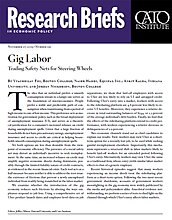Yet both options are less than desirable from the viewpoint of economic efficiency. The presence of a social safety net may distort an individual’s incentive to seek reemployment. At the same time, an increased reliance on credit may amplify negative economic shocks during downturns, possibly through the limited-liability nature of credit contracts, as evidenced in the recent financial crisis. Each tool acts as a half measure because neither is able to address the root issue: the existence of frictions that prevent a newly unemployed individual from readily being rematched in the labor market.
We examine whether the introduction of the gig economy reduces such frictions by altering the ways employees respond to job loss. Using a comprehensive set of Uber product launch dates and employee-level data on job separations, we show that laid-off employees with access to Uber are less likely to rely on UI and untapped credit. Following Uber’s entry into a market, workers with access to the ridesharing platform are 4.8 percent less likely to receive UI benefits. Moreover, they experience a relative decrease in total outstanding balances of $544, or 1.3 percent of the average individual’s debt burden. Finally, we find that the effects of the ridesharing platform extend to credit performance, with workers experiencing a relative decrease in delinquencies of 2.9 percent.
Two economic channels stand out as chief candidates to explain our results. First, workers may view Uber as a short-term option for a recently lost job, to be used while seeking gainful reemployment elsewhere. Importantly, this mechanism represents a structural shift in labor markets likely to benefit laid-off workers for an extended period following Uber’s entry. Alternatively, workers may view Uber the same as a traditional firm, whose entry yields similar labor market effects to that of a generic employer.
Recent historical episodes suggest that many workers experiencing an income shock treat the ridesharing platform as a short-term option. Following the two most recent government shutdowns, accounts of government workers moonlighting in the gig economy were widely publicized by the media and policymakers alike. Anecdotal evidence notwithstanding, we perform a series of tests to shed light on the channel through which Uber’s entry affects labor markets.
First, we focus on the extent of Uber’s effects on the local economy. If Uber affects labor markets like a typical firm, its entry may simply provide new job vacancies that recently unemployed workers are able to fill. This would suggest a transient effect that subsides as vacancies are filled. In contrast, we obtain very similar estimates when excluding the initial two-year period following Uber’s entry into a local economy. In a second test, we focus on a subset of our sample that is less likely to view Uber as a long-term employment prospect.
Using ZIP code–level reported income from the IRS, we repeat our analysis on workers from above-median-income neighborhoods. Our findings indicate that the effects of Uber’s entry remain economically and statistically significant when focusing on this subgroup. Finally, we exploit geographic variation in UI-benefits generosity among states. If a worker treats Uber as a short-term solution and potential substitute for UI, this tradeoff is likely influenced by the potential UI benefits available. On the other hand, if Uber is viewed as long-term employment, then the generosity of short-term UI benefits should not impact the decision to participate on the platform. We find that the effects of Uber’s entry are stronger in states with smaller expected UI benefits.
Overall, this series of tests suggests that Uber alters labor market dynamics by increasing the pool of easily accessible short-term jobs. Importantly, this mechanism represents a structural shift in labor markets that is likely to benefit laid-off workers for an extended period following Uber’s entry.
NOTE:
This research brief is based on Vyacheslav Fos, Naser Hamdi, Ankit Kalda, and Jordan Nickerson, “Gig Labor: Trading Safety Nets for Steering Wheels,” July 5, 2019, https://papers.ssrn.com/sol3/papers.cfm?abstract_id=3414041.

